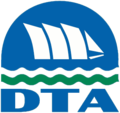 | |
 Duluth Transit Authority bus in downtown Duluth | |
| Founded | 1969 |
|---|---|
| Headquarters | 2402 W. Michigan Street |
| Service area | Twin Ports region of Minnesota and Wisconsin |
| Service type | |
| Routes | 14 |
| Annual ridership | 2,308,998 (2024) |
| Website | duluthtransit |
The Duluth Transit Authority (DTA) is the public transit operator in the Twin Ports region of Minnesota and Wisconsin. DTA operates 15 bus routes throughout the region, serving Duluth, Minnesota; Superior, Wisconsin, and their surrounding suburbs. DTA was founded in 1969 by an act of the Minnesota Legislature, and as of 2024, provides over 2.3 million passenger trips per year. [1] In 2009, the DTA was named Transit System of the Year by the Minnesota Public Transit Association. [2]
Contents
- Routes
- Duluth Transportation Center
- Incidents
- Ridership
- STRIDE
- Fleet
- See also
- References
- External links
DTA operates 14 bus routes in the Twin Ports region. Two "GO Line" routes provide frequent, limited-stop service on key corridors, and a shuttle service operates during summers to connect tourist destinations on the Duluth waterfront.
